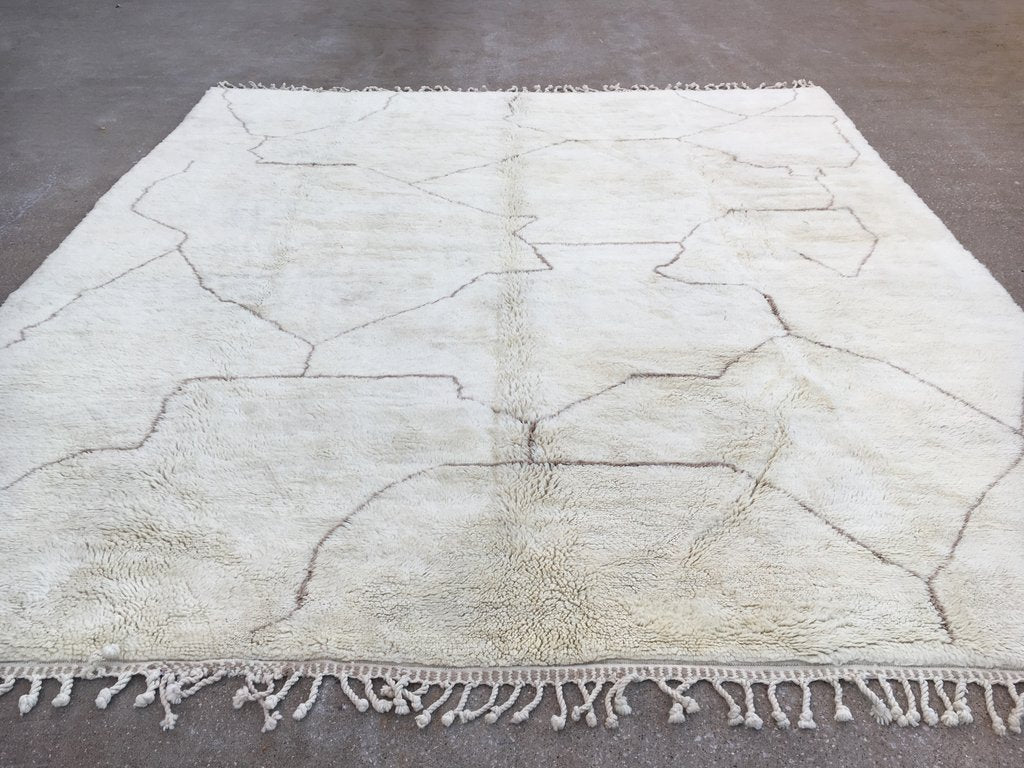When one considers the epitome of luxury and authenticity in the realm of interior design, Beni Ourain rugs immediately spring to mind. These exquisite pieces of art, handwoven by the Berber tribes of the Atlas Mountains in Morocco, have transcended time and trends, remaining a coveted addition to homes around the world. To truly appreciate the allure of Beni Ourain rugs, it is essential to delve into their rich history, cultural significance, and the unique qualities that set them apart.
The Origins of Beni Ourain Rugs: A Tapestry of Heritage
The Beni Ourain people are a group of Berber tribes from the Middle Atlas region of Morocco. Their rugs are a reflection of their way of life, imbued with centuries of tradition and cultural practices passed down through generations. These rugs were not merely decorative items; they served a functional purpose in the harsh climate of the Atlas Mountains, providing warmth during the cold winters.
Historically, the Beni Ourain tribes were semi-nomadic, with their livelihoods centred around livestock farming, particularly sheep. The wool from these sheep, known for its superior quality, became the primary material for weaving rugs. Each rug is a labour of love, taking weeks, sometimes months, to complete. The weaving process is meticulous, with every knot tied by hand, ensuring that no two rugs are identical.
Symbolism and Design: The Language of the Loom
The design of Beni Ourain rugs is steeped in symbolism, often reflecting the weaver’s personal stories, beliefs, and experiences. The most recognisable feature of these rugs is their geometric patterns, typically rendered in a deep black or brown on a natural, undyed cream or white background. These patterns are not random; they are a visual language, with each motif carrying a specific meaning.
Common motifs include diamonds, which symbolise protection against evil, and zigzag lines, representing the unpredictability of life. The simplicity of these designs is deceptive; they are, in fact, complex narratives woven into the fabric of the rug. This storytelling aspect is what makes Beni Ourain rugs more than just floor coverings—they are pieces of history, culture, and identity.
The Rise of Beni Ourain Rugs in Modern Interiors
Despite their ancient origins, Beni Ourain rugs have found a place in modern interiors, beloved by designers and homeowners alike for their timeless elegance and versatility. The rugs’ neutral colour palette allows them to blend seamlessly into a variety of design schemes, from minimalist and Scandinavian to bohemian and eclectic. The juxtaposition of their rustic, handcrafted nature against sleek, modern furnishings creates a striking contrast that adds depth and character to any space.
The rise in popularity of Beni Ourain rugs can also be attributed to a growing appreciation for artisanal, handcrafted goods in an age dominated by mass production. As consumers become more discerning, seeking out unique and authentic pieces, the demand for these rugs has soared. However, their value goes beyond mere aesthetics; owning a Beni Ourain rug is about embracing a piece of Moroccan heritage and supporting the artisans who continue this age-old craft.
Craftsmanship: The Art of Weaving Beni Ourain Rugs
The craftsmanship involved in creating a Beni Ourain rug is nothing short of extraordinary. The process begins with the selection of wool, which is carefully chosen for its softness, durability, and natural sheen. The wool is then washed and spun by hand, a practice that has remained unchanged for centuries. This hand-spun wool forms the foundation of the rug, giving it a texture and quality that machine-made rugs cannot replicate.
Weaving a Beni Ourain rug is a time-intensive process, requiring immense skill and patience. The weavers, predominantly women from the Berber tribes, work on vertical looms, tying each knot by hand. This knotting technique, known as the Berber knot or double knot, is what gives the rug its characteristic thick pile and plush feel underfoot.
Once the weaving is complete, the rug is washed and left to dry in the sun. This final step enhances the natural colours of the wool and gives the rug its soft, luxurious finish. It is this dedication to quality and authenticity that ensures each Beni Ourain rug is a masterpiece in its own right.
Preserving the Legacy: Beni Ourain Rugs in the 21st Century
In today’s globalised world, the demand for Beni Ourain rugs has extended far beyond Morocco’s borders. However, with this popularity comes the challenge of preserving the authenticity and cultural significance of these rugs. Many of the rugs available on the market today are mass-produced imitations that lack the quality and soul of the original handwoven pieces.
To ensure the legacy of Beni Ourain rugs continues, it is crucial to support the artisans who keep this tradition alive. Organisations and cooperatives are working to promote fair trade practices, ensuring that the weavers receive fair compensation for their work. By purchasing an authentic Beni Ourain rug, one not only acquires a beautiful piece of art but also contributes to the preservation of a cultural heritage that has withstood the test of time.
How to Identify an Authentic Beni Ourain Rug
With the market flooded with replicas, knowing how to identify an authentic Beni Ourain rug is essential. There are several key features to look for:
- Material: Authentic Beni Ourain rugs are made from 100% natural wool. The wool should be soft to the touch with a slight sheen. If the rug feels overly synthetic or lacks the natural imperfections of hand-spun wool, it is likely a fake.
- Weave: Examine the back of the rug. The knots should be clearly visible, and the weave should be consistent but not perfect, reflecting the handwoven nature of the rug. Machine-made rugs often have a uniform, too-perfect appearance.
- Design: The patterns on an authentic Beni Ourain rug are typically asymmetrical, with slight variations that add to the rug’s charm. Perfect symmetry is often a sign of a mass-produced rug.
- Colour: Authentic Beni Ourain rugs are made from undyed wool, resulting in a natural cream or white background. The patterns are usually in black or brown, created using natural dyes. Bright, synthetic colours are a red flag.
- Price: While price alone is not a definitive indicator of authenticity, a genuine Beni Ourain rug is a significant investment. If the price seems too good to be true, it probably is.
Caring for Your Beni Ourain Rug
Investing in a Beni Ourain rug is not only a purchase but a commitment to preserving its beauty and longevity. Proper care is essential to ensure that your rug remains a cherished part of your home for years to come.
- Vacuuming: Regular vacuuming is crucial to prevent dirt and dust from becoming embedded in the fibres. Use a vacuum without a beater bar to avoid damaging the wool.
- Cleaning: Spot cleaning with a mild detergent and cold water is recommended for minor spills. For more extensive cleaning, it is advisable to seek professional cleaning services that specialise in wool rugs.
- Rotation: To ensure even wear, rotate your rug every few months. This is particularly important in high-traffic areas.
- Protection: Avoid placing your Beni Ourain rug in direct sunlight, as prolonged exposure can cause the colours to fade. Using a rug pad can also help to protect the rug and prevent it from slipping.
Conclusion: The Enduring Appeal of Beni Ourain Rugs
The enduring appeal of Beni Ourain rugs lies in their timeless elegance, rich history, and the unparalleled craftsmanship that goes into their creation. These rugs are more than just decorative items; they are tangible connections to a centuries-old tradition and a testament to the artistry of the Berber people. Whether you are drawn to their aesthetic beauty, cultural significance, or the story they tell, owning a Beni Ourain rug is an invitation to bring a piece of Moroccan heritage into your home—a legacy that will be cherished for generations to come.

